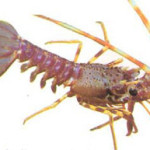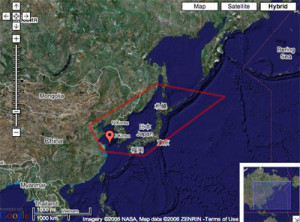The Yellow Sea is one of the most intensively exploited areas in the world. There are over 270 fish species, with about 100 species of fish and crustacea being commercially harvested. This exploitation of the Sea¬πs resources means that over time, stocks some of the more commercially valuable species have declined, to be replaced by smaller, less valuable species.
The Sea of Japan (also known as the East Sea) is another highly productive, semi-enclosed sea, connected to the Sea of Okhotsk, the Northern Pacific Ocean and the East China Sea through four shallow straits. The shallowness of these straits limits the water flow in and out of the Sea and contributes its semi-enclosed character.
The Tsushima Current, a small branch of the warm Kuroshio Current, enters the Sea of Japan through the Tsushima Strait between Kyushu and Korea and flows out to the Pacific through the Tsugaru and Soya Straits. The average depth of the sea is 1350 metres. The northwestern area of the Sea is colder than the remaining southerly part, with sharp declines in temperature in the winter and ice forming in the Tartarskiy Strait from November to April. Seasonal temperature fluctuations are as high as 20 degrees C in the northwestern portion, and 14 degrees C in the southern portion, allowing the region to support tropical to Arctic species.
Commercially important species include sardine, flounder, Pacific cod, Pacific salmon, red sea bream, with the Japanese sardine (Sardinops melanostica), one of the most abundant pelagic fish in the Sea of Japan, contributing more than 70 percent of the total catch.
The country that is Japan is actually an archipelago that stretches over 3000 kilometres from north to south. Because of this, northern Japan is located in the North Temperate Zone, experiencing temperatures that range from cool to cold, while the southern Japanese islands, (outside this eco-region) are situated near the Tropic of Cancer and enjoy tropical temperatures. Summers are humid and hot, whilst areas impacted by the Asian monsoons suffer severe weather, despite the temperate latitude.
Most areas of Japan have a rainy season, known as tsuyu, sometime during June and July, with occasional typhoons, from August to October, bringing heavy rains and high winds to some parts of the region. High levels of land reclamation and coastal development has led to the destruction of mangrove areas and harmed extensive areas of coral reef in the south of Japan. Oil pollution is a significant problem along major shipping routes and an increasing number of accidents have occurred in recent years.
The former Soviet Union and now Russia have reportedly dumped radioactive waste in the Sea of Japan.
Download the pre-dive briefing pack for this eco-region here.






Social Profiles